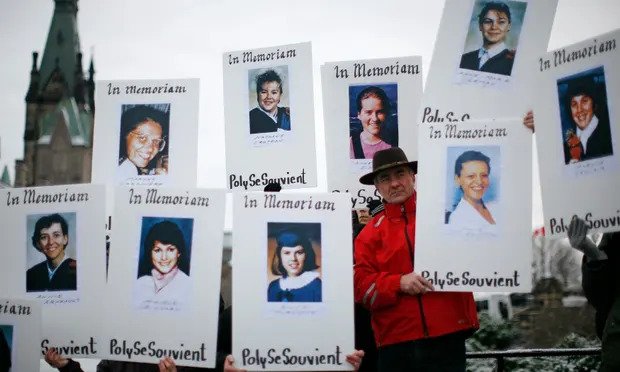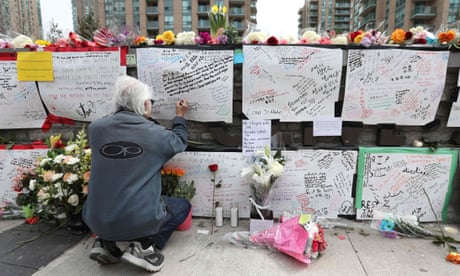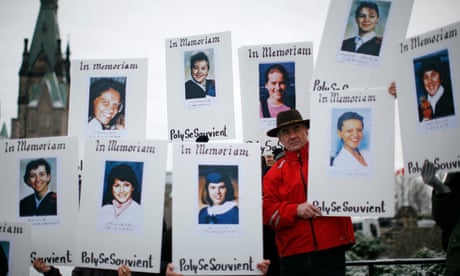Violence linked to the ideology has killed as many as 50 people in the US and Canada and sparked debate among counterterrorism experts and police.
 Demonstrators hold portraits during a rally to commemorate the Montreal mass shooting of 14 female engineering students in 1989. Photograph: Chris Wattie/Reuters
Demonstrators hold portraits during a rally to commemorate the Montreal mass shooting of 14 female engineering students in 1989. Photograph: Chris Wattie/Reuters
–
As attacks linked to the misogynist “incel” movement mounted in recent years, authorities around the world have begun to treat the ideology as a more serious terrorism threat.
Since 2014, men who call themselves “involuntary celibates” and blame women for their own lack of sexual and social status have carried out mass killings in California, Florida, and Toronto.
On Wednesday, a judge in Canada delivered a guilty verdict for the perpetrator of the 2018 Toronto van attack, which left 10 people dead and 16 injured – one of the deadliest incidents linked to the incel movement.
–

In her verdict, the judge found that the attacker’s resentment towards women was one among several motivating factors, but experts warn that such incidents are becoming more frequent, and that the ideology behind them is spreading internationally.
2020 saw a string of incel-related incidents, including a machete attack at a Toronto massage parlor, a shooting at an Arizona mall which injured three people, a man who blew up his own hand with explosives in Virginia, and a New York man charged by federal prosecutors for targeting a couple with violent threats.
While only one of those attacks was fatal, “the fact those incidents weren’t worse is more luck than good counterterrorism,” said Jacob Ware, a terrorism researcher who studies the incel movement. “2020 was a bad year for incel violence.”
There are also signs the ideology is spreading beyond North America: in the UK, at least two recent terror trials included discussion of incel ideas as a motivation.
And as incel-related attacks have multiplied, the ideology has begun to get more attention from both law enforcement and counterterrorism researchers, sparking debate over whether it is useful to classify this kind of ideological violence against women as terrorism.
Last spring, Canada announced terrorism charges against a 17-year-old Toronto resident for the murder of 24-year-old Ashley Noelle Arzaga at a massage parlor, an attack law enforcement said was motivated by incel extremism. It was the first time Canada had charged anyone with incel-related terrorism.
Incel-related violence “seems to be increasing,” said Alex DiBranco, the executive director of the Institute for Research on Male Supremacism, and one of the authors of a recent report on misogynist violence. And, despite growing attention, “It’s still not being taken as seriously as it needs to be.”
Measuring the toll
By some counts, incel-related attacks in the United States and Canada have claimed as many as 40 to 50 lives, DiBranco and Ware said. But that statistic includes the toll of several large school shootings – including a 2015 shooting at a college in Roseburg, Oregon and a 2018 high school shooting in Parkland, Florida – in which the perpetrators made some mention of incel ideology alongside other grievances.
The number of casualties in the attacks most clearly motivated by incel ideology is smaller, and starts with the 2014 Isla Vista attack at the University of California, Santa Barbara, in which a 22-year-old killed six people and injured 14 others.
The Isla Vista perpetrator has been cited as a direct inspiration by other attackers, including the 28-year-old Canadian man convicted on Wednesday who posted about an “incel rebellion” on Facebook shortly before plowing his rental van into pedestrians on a Toronto street.
–

There are other attacks that predate the growth of the online incel movement, but that fit a similar pattern of anger towards women, including a 2009 attack on a fitness center in Pennsylvania, and the mass shooting of 14 female engineering students in Montreal in 1989 by a man who wrote of his rage against feminism.
So far, incel-related violence has not become a terror threat in the United States on the same scale as other violent ideologies, according to an analysis of domestic terror attacks by the New America Foundation.
Since 9/11, far rightwing attacks killed 114 people, and jihadist attacks had killed 107 people, while only nine people had been killed in American misogynist and incel attacks, the New America Foundation analysis found.
This count includes a July 2020 attack, in which an anti-feminist lawyer opened fire at the home of a female federal judge in New Jersey, leaving her son dead, an attack experts said was linked to misogyny, but not the incel movement specifically.
But incel terrorism in the United States has been much deadlier than far-left terrorism, which receives intense political and media attention in the US, the New America analysis found. Its data lists only a single person killed in a far-left attack in the US since 9/11.
What response is right?
Some experts are skeptical of the value of approaching the incel movement through a counterterrorism lens, rather than as a public health problem, said Ware adding that some see a risk in making the movement “look like a bigger deal than it is”.
“Incels display very high levels of mental health issues. They display high levels of a history of bullying. This is a movement that is desperately sad,” he said.
At the same time, he said, “Incel violence is ideological violence against civilians, to prove an ideological point or create psychological fear. That makes it terrorism.”
The Isla Vista shooter made clear in his manifesto that he wanted to make women afraid, said DiBranco.
“Though misogynist incels are often perceived as a movement without political aims, violent perpetrators have the same type of far-reaching aims that white nationalists have: to completely change the culture and politics of society to favor their own group,” she and her co-authors wrote in a February report.
“This is an ideology. It’s not a psychological disorder,” she said. “There’s a lot of undue sympathy.”
–
–
As 2021 unfolds …
… we have a small favor to ask. Through these turbulent and challenging times, millions rely on the Guardian for independent journalism that stands for truth and integrity. Readers chose to support us financially more than 1.5 million times in 2020, joining existing supporters in 180 countries.
For 2021, we’re committing to another year of high-impact reporting that can counter misinformation and offer an authoritative, trustworthy source of news for everyone. With no shareholders or billionaire owner, we set our own agenda and provide independent journalism that’s free from commercial and political influence. When it’s never mattered more, we can investigate and challenge without fear or favor.
Unlike many others, we have never put up a paywall. We have chosen to keep Guardian journalism free and open for all readers, regardless of where they live or what they can afford to pay. We do this because we believe everyone deserves to read accurate news and thoughtful analysis.
In the last year alone, we offered readers a comprehensive, international perspective on critical events – from the Black Lives Matter protests, to the US presidential election, Brexit, and the ongoing pandemic. We enhanced our reputation for urgent, powerful reporting on the climate emergency, and made the decision to reject advertising from fossil fuel companies, divest from the oil and gas industries, and set a course to achieve net zero emissions by 2030.
If there were ever a time to join us, it is now. Every contribution, however big or small, powers our journalism and helps sustain our future. Support the Guardian from as little as $1 – it only takes a minute. If you can, please consider supporting us with a regular amount each month. Thank you.













